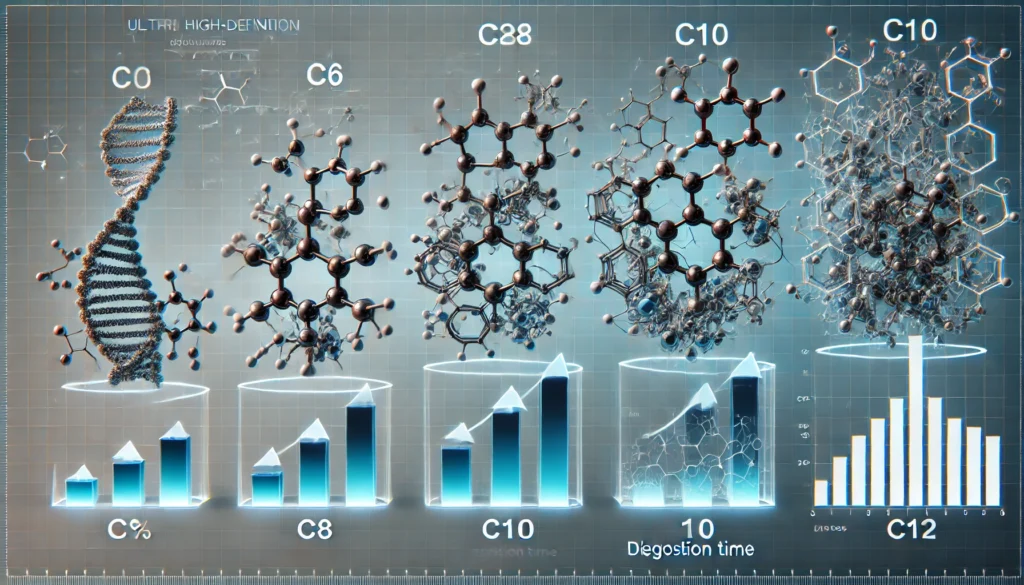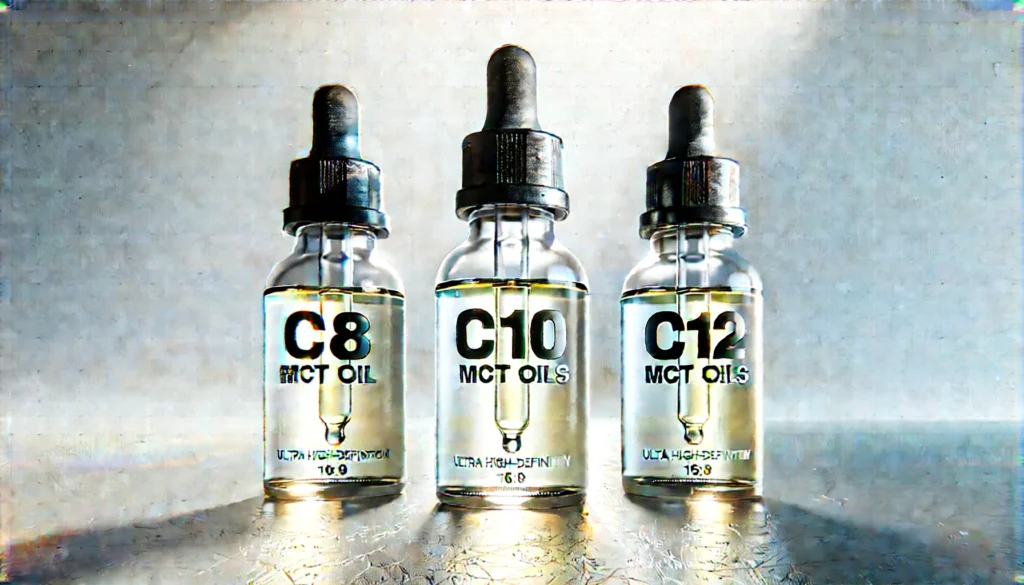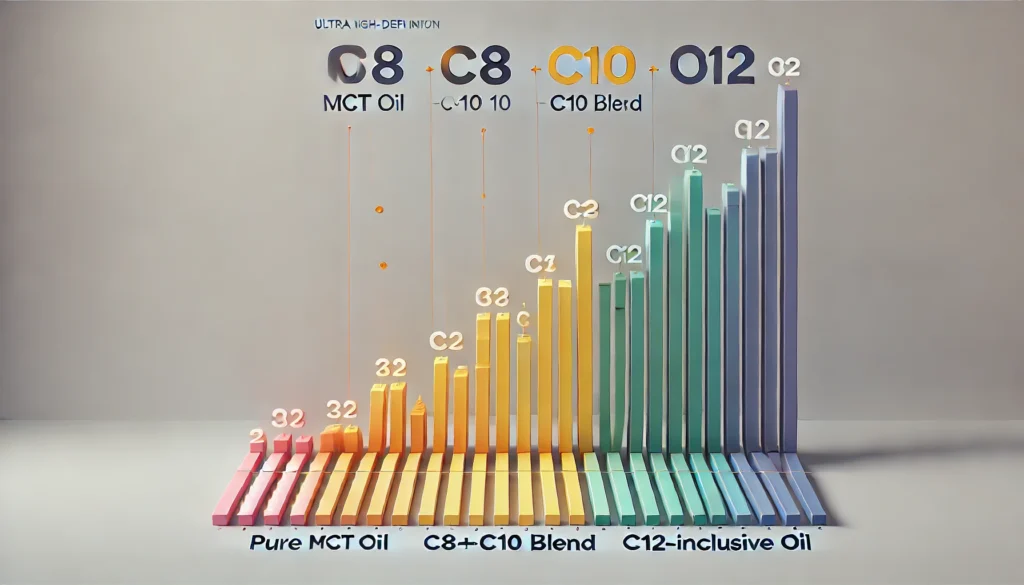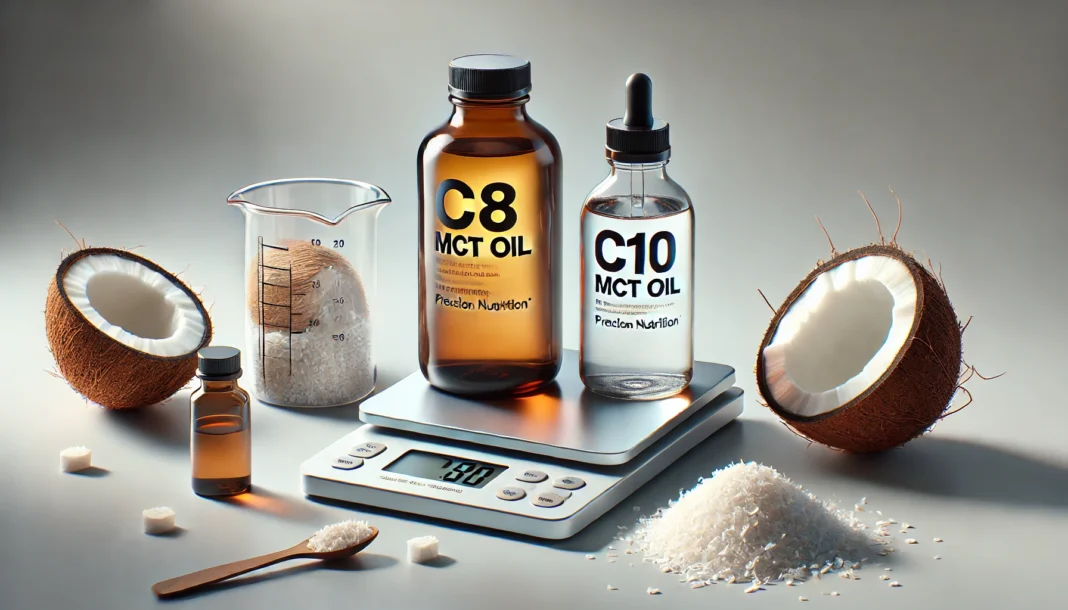Introduction
Medium-chain triglycerides (MCTs) have become a powerful topic of research and discussion in nutritional science, particularly as their relevance to metabolic health, energy metabolism, brain function, and weight management gains global attention. Unlike long-chain fats, MCTs are quickly absorbed by the body and rapidly converted into energy by the liver. Among these, MCT oil containing C8 and C10—commonly known by their scientific names caprylic acid (C8) and capric acid (C10)—are especially prized for their bioavailability and physiological benefits. As more consumers shift toward targeted nutrition, distinguishing between MCT oil C8 C10 C12 and understanding why some formulas exclude C12 becomes critically important.
You may also like: MCT Oil for Dementia and Brain Health: Exploring Its Role in Memory, Function, and Alzheimer’s Support
This article delves deep into the molecular structure, health implications, and therapeutic potential of C8 and C10 MCTs. We examine the metabolic impact of each MCT type, explore why some experts prefer MCT oil without C12, and clarify the functional differences in various formulations. Whether you’re trying to determine which MCT oil is best C8 C10 for energy optimization, brain fuel, or gut health, this guide will provide an evidence-based perspective grounded in clinical findings and expert consensus.
By the end, you’ll not only understand the key distinctions between c8 mct oil vs mct oil blends but also be able to choose intelligently based on your unique health goals. Let’s begin by decoding the different types of MCT oil and the significance of each fatty acid chain length in human health.

What Are Medium-Chain Triglycerides and Why Chain Length Matters
Medium-chain triglycerides are saturated fatty acids that range in length from six to twelve carbon atoms. They include four primary types: caproic acid (C6), caprylic acid (C8), capric acid (C10), and lauric acid (C12). While all these are technically classified under MCTs, they vary considerably in how they’re metabolized by the body.
Caprylic acid (C8) is known for being the fastest-absorbing and most ketogenic of the MCTs. It bypasses the typical digestive process, traveling directly to the liver where it’s rapidly converted into ketones, a crucial alternative energy source for the brain and muscles. C8 is often isolated in high-performance supplements for those seeking enhanced cognitive performance or quicker entry into nutritional ketosis.
Capric acid (C10), slightly longer than C8, also converts efficiently into ketones but at a slower rate. When combined in MCT oil C8 C10 blends, the result is a balanced effect—C8 offers immediate ketone production, while C10 provides a more sustained release of energy.
Lauric acid (C12), on the other hand, behaves more like a long-chain fatty acid and doesn’t rapidly convert to ketones. While C12 has antimicrobial properties and is abundant in coconut oil, it’s often omitted from MCT oils marketed for fast energy or cognitive support due to its delayed digestion and lower ketone yield. This explains the growing demand for MCT oil without C12, especially among athletes and ketogenic dieters.
Thus, when evaluating types of MCT oil, it becomes essential to recognize the structural and metabolic differences that distinguish C8 and C10 MCT from C12-dominant formulations. Consumers looking for performance-enhancing effects tend to prioritize blends with higher ratios of C8 and C10 or purely opt for MCT oil C8 C10 formulations.

Metabolic Advantages of C8 and C10 MCT Oils
One of the most studied benefits of C8 MCT oil vs MCT oil containing longer chains is the superior ability of C8 to promote ketogenesis. This process increases circulating ketone bodies, such as beta-hydroxybutyrate (BHB), which are associated with improved mental clarity, energy levels, and metabolic flexibility.
In several human studies, C8 has been shown to elevate plasma ketone concentrations more significantly than C10 or C12. This makes it a preferred choice for individuals following ketogenic diets, intermittent fasting, or low-carb protocols. MCT C8 vs C10 comparisons have consistently demonstrated that while both offer metabolic advantages, C8 leads in terms of speed and efficacy for ketone production.
C10 MCT, while slightly slower, has its own set of merits. It tends to be more tolerable for some individuals in terms of digestion and may provide a more sustained energy curve without the rapid spike seen with pure C8. In blends such as MCT oil C8 C10, the synergy allows for both fast-acting and longer-lasting energy support, especially useful in endurance athletes or those needing stable blood sugar support.
Further, both C8 and C10 possess antimicrobial and gut-supporting properties. While C12 excels in these domains, recent studies indicate that C8 and C10 MCT can inhibit pathogenic bacterial growth in the gut, supporting microbiome balance and improving gastrointestinal resilience. These properties also make them useful in supporting immune health and fighting off low-grade inflammation linked to dysbiosis.

Why Many People Prefer MCT Oil Without C12
Despite its inclusion in the MCT family, lauric acid (C12) is often excluded from high-performance MCT formulations. There are several reasons for this. First, C12 behaves like a long-chain fatty acid during digestion, requiring bile acids and enzymatic action for breakdown. This reduces its speed of absorption and energy conversion compared to C8 and C10 MCT.
Second, the ketogenic benefits of lauric acid are minimal. In trials comparing C8 MCT oil vs MCT oil with higher C12 content, participants consuming C8 showed elevated blood ketones, while those on C12-heavy oils did not. For individuals seeking cognitive enhancement, appetite control, or endurance optimization through ketosis, this distinction is critical.
Third, purity and efficacy are often diluted in formulas that include C12. Brands offering MCT oil C8 C10 C12 typically derive the oil from standard coconut or palm sources without further distillation, meaning the percentage of potent C8 and C10 is lower. Premium oils that are labeled as MCT oil C8 C10 or even pure C8 undergo fractional distillation to isolate only the most bioavailable fatty acids.
As a result, health-conscious consumers increasingly ask, which MCT oil is best C8 C10, especially when their primary goal is metabolic enhancement, mental clarity, or gut health. Removing C12 ensures cleaner, faster energy and better performance outcomes.

Scientific Comparison: C8 MCT Oil vs MCT Oil Blends
To fully appreciate the distinctions, we must examine C8 MCT oil vs MCT oil from a scientific standpoint. Pure C8 MCT oil, often derived from coconut oil and refined through distillation, is composed almost entirely of caprylic acid. This form is absorbed through the portal vein and immediately converted to ketones.
Studies published in the Journal of Clinical Nutrition show that participants consuming C8 oil saw a 300% greater rise in ketone levels compared to those consuming mixed MCT oils. This translated to improved cognitive performance in memory tasks and faster post-workout recovery times.
Meanwhile, MCT oil C8 C10 formulations present a middle ground. The presence of C10 slightly lowers the ketone response but improves digestive comfort for some individuals. It’s also more affordable than pure C8, making it a practical option for daily use.
Blends that include C12, however, have not shown consistent performance benefits. Most trials show no significant increase in circulating ketones with lauric acid. Hence, the MCT oil without C12 trend aligns with evidence-based recommendations for therapeutic MCT supplementation.
Ultimately, MCT C8 vs C10 is less about one being better and more about aligning each with specific goals. C8 is ideal for fast mental energy and keto adaptation. C10 supports endurance and smooth digestion. Together, they represent the most effective MCT profile for biohackers, athletes, and those with metabolic needs.
Health Benefits of C8 and C10 MCT Oils
The spectrum of health benefits associated with MCT oil C8 C10 is both wide and impressive. These include enhanced cognitive performance, fat oxidation, improved mitochondrial health, appetite suppression, and more stable energy levels.
Brain health is one of the standout benefits. Because ketones produced from C8 and C10 MCT cross the blood-brain barrier, they provide immediate fuel for neurons—especially important in neurodegenerative conditions like Alzheimer’s disease. Preliminary trials suggest ketone supplementation via MCT oil may slow cognitive decline and improve memory in early-stage dementia.
Weight management is another key application. C8 MCT oil vs MCT oil studies reveal that participants consuming C8 experience greater satiety, reduced caloric intake, and increased thermogenesis compared to those using longer-chain fats or even mixed MCT blends. This makes MCT oil without C12 particularly suitable for weight loss protocols.
Athletic performance is also improved by the rapid bioavailability of C8 and C10. Both medium-chain fats spare muscle glycogen, support post-exercise recovery, and extend endurance during prolonged activity. This makes C8 and C10 MCT oils a mainstay in sports nutrition, often consumed before or during intense workouts.
Finally, gut health and immunity benefit from the antimicrobial properties of these fatty acids. While C12 is most noted for this, emerging data show that types of MCT oil containing high C8 and C10 can combat harmful bacteria while sparing beneficial strains. This helps reduce bloating, inflammation, and gut permeability—all markers of a healthy digestive system.
Frequently Asked Questions
1. What is the difference between C8 and C10 MCT oil?
C8, or caprylic acid, is an eight-carbon fatty acid that is rapidly absorbed and converted into ketones, offering quick energy and enhanced mental clarity. C10, or capric acid, has ten carbons and is also converted to ketones, but at a slightly slower rate. When combined in MCT oil C8 C10 blends, the benefits of both fast and sustained energy release can be achieved. Compared to C12, these two are more bioavailable and metabolically active, especially for those on ketogenic or low-carb diets. Each has distinct properties, and choosing between them depends on specific goals like mental focus, endurance, or digestive comfort.
2. Why is C12 often excluded from premium MCT oil?
While lauric acid (C12) is technically a medium-chain triglyceride, its behavior in the body is more like a long-chain fat. It requires bile and enzymes to digest, making its absorption slower and ketone conversion negligible. This contrasts sharply with C8 and C10 MCT, which bypass normal digestion and go directly to the liver for fast energy. Because of this metabolic delay and the reduced therapeutic benefit, many health-focused products now promote MCT oil without C12 for cleaner, faster, and more efficient energy metabolism.
3. Is pure C8 better than C8 C10 MCT oil blends?
Pure C8 oils provide the most immediate increase in ketone production and mental performance, making them ideal for individuals needing quick cognitive energy or rapid ketosis. However, some people may find that pure C8 causes digestive discomfort. In such cases, MCT oil C8 C10 blends offer a more balanced alternative with slightly slower but smoother effects. The blend still supports energy and fat burning but is often better tolerated for daily use. It depends on individual sensitivity, budget, and health goals when comparing C8 MCT oil vs MCT oil with both chains.
4. Can MCT oil improve gut health?
Yes, C8 and C10 MCT have been shown to possess antimicrobial properties that help suppress harmful bacteria like Candida albicans and certain strains of E. coli. This leads to better microbiome balance, reduced inflammation, and improved gut barrier function. While C12 has the strongest antimicrobial effects, MCTs with high C8 and C10 content can support gut health without the digestive delays associated with longer-chain fats. Individuals dealing with bloating, indigestion, or microbiome imbalance may benefit from types of MCT oil that favor C8 and C10 specifically.
5. How does MCT oil affect weight loss?
MCTs like C8 and C10 MCT increase thermogenesis, promote fat oxidation, and reduce appetite, all of which can contribute to weight loss. C8 in particular has been shown to boost metabolic rate and induce greater satiety after meals. MCT oil without C12 is typically more effective in fat-loss protocols due to its higher ketogenic potential and rapid energy turnover. When paired with a low-carb or calorie-controlled diet, MCT oil becomes a useful adjunct for sustainable weight management.
6. Is there an optimal time to take MCT oil?
Most people consume MCT oil C8 C10 in the morning or before workouts to capitalize on the energy-enhancing effects. When used during intermittent fasting, C8-based MCT oil can help extend the fast while supporting mental clarity and energy. Some may also take it post-meal to reduce glycemic spikes or enhance satiety. Consistency and dosage matter more than timing, but aligning intake with energy demands or cognitive load often delivers the best results. Starting with 1 teaspoon and gradually increasing is advised to avoid digestive discomfort.
7. What are the best sources of C8 and C10 MCT oils?
High-quality types of MCT oil are typically derived from coconuts using a process called fractional distillation, which isolates C8 and C10 while removing C12 and other long-chain fats. Look for oils that specify exact ratios or state MCT oil C8 C10 on the label. Avoid generic “coconut MCT oil” unless the C8/C10 content is clearly listed. Reputable brands often offer lab-tested purity and transparency in sourcing. Organic, non-GMO certifications are also a plus for those seeking the cleanest product possible.
8. Are there any side effects of taking MCT oil?
Some users may initially experience digestive upset such as cramping, loose stools, or nausea when starting MCT oil, especially pure C8. Gradually introducing C8 and C10 MCT blends can help reduce these symptoms. Taking the oil with food rather than on an empty stomach often improves tolerance. Overconsumption can also lead to excessive calorie intake, so moderation is key. When used properly, side effects are rare and transient, particularly with MCT oil without C12, which tends to be more easily absorbed.
9. Can MCT oil be used for medical conditions?
Yes, MCT oil is often used in clinical settings for patients with fat malabsorption disorders, epilepsy, or Alzheimer’s disease. Its ability to provide quick energy and bypass compromised digestion makes MCT oil C8 C10 a therapeutic tool in many integrative protocols. Neurologists use it for seizure control, while nutritionists use it to manage metabolic syndrome and insulin resistance. However, it should be used under medical supervision in such cases, especially when paired with other treatments.
10. What’s the best way to store MCT oil?
MCT oil is shelf-stable at room temperature and should be stored in a cool, dark place to preserve its integrity. High-quality C8 and C10 MCT oils have a long shelf life due to their saturated structure, which resists oxidation. There is no need to refrigerate, but keeping the bottle sealed and away from sunlight is important. If the oil develops an off smell or taste, it may have degraded and should be replaced.

Conclusion
As research continues to validate the physiological impact of medium-chain triglycerides, it becomes increasingly clear that not all MCTs are created equal. The superior metabolic activity of caprylic acid (C8) and capric acid (C10) positions them at the forefront of functional health, sports nutrition, and cognitive optimization. In contrast, lauric acid (C12), though beneficial in its own right, lacks the immediate energy-enhancing properties that many consumers seek.
Whether your goals include enhanced brain function, weight loss, stable energy, or improved gut health, choosing the right MCT oil can make all the difference. Understanding the science behind C8 MCT oil vs MCT oil blends and knowing which MCT oil is best C8 C10 for your needs enables more targeted supplementation. The growing popularity of MCT oil without C12 reflects an informed demand for products that deliver rapid, efficient, and reliable results.
Ultimately, the choice between MCT C8 vs C10 comes down to personal bioindividuality. But for most, a high-quality MCT oil C8 C10 formulation offers the best of both worlds: quick ketone production and smoother digestion. As part of a well-rounded nutrition strategy, this functional fat continues to redefine what it means to fuel the body and mind efficiently and effectively.
Was this article helpful? Don’t let it stop with you. Share it right now with someone who needs to see it—whether it’s a friend, a colleague, or your whole network. And if staying ahead on this topic matters to you, subscribe to this publication for the most up-to-date information. You’ll get the latest insights delivered straight to you—no searching, no missing out.
Further Reading:
Can You Cook With MCT Oil? Exploring the Science of Cooking With MCTs
Brain Octane Oil vs MCT Oil: Scientific Comparison, Benefits, and How to Choose the Right One



